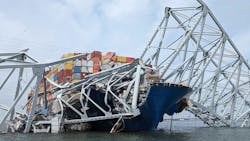The Moments Before the Francis Scott Key Bridge Collapse, The Daunting Cleanup and Aging Infrastructure: What We're Reading This Week
In late March, my partner and I drove over 1,000 miles to Texas. On our way there, I frequently commented about seeing our tax dollars at work because there were so many bridges, overpasses and roads being built, expanded or repaired. We even encountered some night construction and bad bumper to bumper traffic from about 10 p.m. till midnight in Kentucky. A few days later, the Francis Scott Key bridge collapsed.
On the drive back, I thought about how our aging infrastructure and how much still needs replaced. I decided to investigate the safety of the I-40 Hernando DeSoto bridge, which crosses the Mississippi River and connects Memphis and Arkansas. What I found made me nervous, even though I read about it from the comfort of my own home.
“A contractor working for the Arkansas Department of Transportation (ArDOT) noticed a gaping crack in a hollow steel girder, threatening the entire bridge span with collapse,” according to an archived story from KUAR, the NPR-affiliate in Little Rock, Arkansas. “The situation was so dire that the contractor called 911, and authorities shut down traffic within hours.” The DeSoto bridge serves as reminder that inspections can save lives—and that we must do more to maintain the roads and bridges we traverse every day.
This week, I was asked to be a panelist on Production Pulse, a weekly conversation with editors at my company, Endeavor Business Media. This week’s episode was focused on the aftermath of the Key Bridge collapse, with a focus on the manufacturing, trucking, and building and construction industries.
In addition to the news story that EHS Today published in late March, I thought you might like to readsummaries of some of the articles I did to prepare for my panel discussion
Until next time, stay safe and be well.
The Moments Before the Collapse
It’s surreal to see video of the bridge collapse seconds after being struck by a cargo ship.
The swift action from the Dali crew and emergency responders helped keep many more people out of harm’s way. But we must also assess how and why those six construction workers lost their lives.
According to reports, those mayday calls didn’t reach the construction workers, nor does it appear that the construction company had a rescue boat nearby. Federal regulations require construction companies to have skiffs on hand when crews are working over or near water.
Some safety engineers and maritime lawyers have called for an investigation about the skiff, or lack thereof, along with other safety concerns. A spokesperson for the Maryland Occupational Safety and Health declined to comment to the Associated Press, citing the open investigation.
Given the speed with which the bridge fell, some construction experts question whether a skiff would’ve made a difference—or worse, if it would’ve put more people’s lives at risk that fateful night.
As safety professionals, you’re well-aware of federal or state OSHA requirements; you understand that you must take safety precautions at every jobsite. The Key Bridge collapse is a tragic reminder of how important safety is and all the work that must go into place to ensure workers return home safely to their families.
Read the full story here.
The Daunting Cleanup
Elected officials, from Baltimore Mayor Brandon M. Scott to President Joe Biden, have vowed to rebuild the bridge that completed the Interstate-695 loop. But before any plans can be drawn, the wreckage needs to be cleaned up.
That is no small task. The Dali needs to be moved. The Dali’s 4,700 shipping containers, some of which were plunged into the water, need to be moved. The 1.6-mile bridge itself has to be removed.
“We all have to understand as we’re looking at the scene how incredibly dangerous it is right now,” said Natalie Simpson, a professor of operations management and strategy at the University at Buffalo, told Marketplace. “It’s supposed to be floating and it’s not, and it’s loaded on the top with an unthinkable amount of tonnage. It is not structurally stable.”
Removing all these materials from the water requires plenty of specialized equipment, including crane barges that can be the size of a football field. This work also requires skilled workers, such as divers who will have to plug the holes in the Dali using special oxygen-fueled underwater arc torches. Because the ship was carrying hazardous materials, extra precautions will need to be taken to ensure everyone and everything’s safety throughout the cleanup process.
Read the full story here.
More Bridges Vulnerable
It’s always important to look for lessons learned following any incident, as it can help to prevent similar incidents from occurring in the future. It seems that what happened to the Key Bridge could happen to many other bridges in the United States.
In fact, the Chesapeake Bay Bridge near Annapolis, Maryland—where some of the Key Bridge ships are being rerouted to—is just as vulnerable to collapse. That’s disconcerting, to say the least.
CNN asked experts to review some of the bridges that lead to some of the nation’s biggest ports. Many have dolphins, barrier islands and other protective measures, yet some contain “fracture critical members,” meaning that if a single element is damaged, the entire bridge could fall.
Authors Casey Tolan, Isabelle Chapman, Curt Devine and Yahya Abou-Ghazala write: “Experts disagree about whether any kind of protection could realistically save a bridge from a direct hit by a container ship as massive as the Dali, the vessel that took out the Key Bridge. But they say the collapse should require a renewed risk assessment and investment in defense systems that could at least reduce the possibility of such a disaster.”
I highly recommend you read the article to learn more about how bridges are designed to withstand collisions, how container ships have gotten bigger (and how that poses greater threats) and how to be proactive in the future.
Read the full article here.
About the Author
Nicole Stempak
Nicole Stempak is managing editor of EHS Today and conference content manager of the Safety Leadership Conference.

